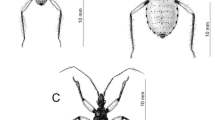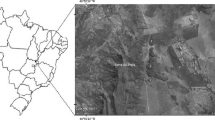Abstract
Ecological demands were studied in Elaphrus cupreus, a frequent species, and E. uliginosus, one of the most endangered carabids in Europe. Ecological experiments were performed in the laboratory and the field in northern Germany. Abundance was measured using the mark-and-recatch method. Both species prefer sites with water content changes lower than 25%. E. uliginosus prefers higher temperatures than E. cupreus and niche breadth was on average wider in E. cupreus than in E. uliginosus. E. uliginosus is restricted to grassland sites with a low fraction (>0 and 25%) of bare soil. E. cupreus was mainly found on sites having >75–100% bare soil. This preference of E. uliginosus can be referred to its high temperature demands using open regions for warming up and its predatory behaviour using hideouts for a rapid predatory push. The wider niche structure and lower temperature demand of E. cupreus allows the inhabitation of cooler alder woods. It prefers large fractions of bare soil because its predatory behaviour is to run randomly on the soil. Thus, E. uliginosus demands wet extensively grazed grassland where cattle produces low fractions of bare soil, while E. cupreus prefers intensively grazed sites in grassland or alder woods.






Similar content being viewed by others
References
Abrams P (1980) Some comments on measuring niche overlap. Ecology 61:44–49
Andersen J (1985) Ecomorphological adaptations of riparian Bembidiini species (Coleoptera: Carabidae). Entomol Generalis 11:41–46
Bauer T (1974) Ethologische, autökologische und ökophysiologische und ökophysiologische Untersuchungen an Elaphrus cupreus Dft. und Elaphrus riparius L. (Coleoptera, Carabidae). Oecologia 14:139–196
Bauer T, Bath M (1976) Zur etho-ökologischen Differenzierung und Nischenbildung der Raschkäfer-Arten Elaphrus riparius, aureus und ulrichi (Coleoptera, Carabidae). Entomol German 2:209–216
Burmeister F (1939) Biologie, Ökologie und Verbreitung der europäischen Käfer auf systematischer Grundlage. I. Band: Adephaga Hans Goecke, Krefeld
Desender K, Turin H (1989) Loss of habitats and changes in the composition of the ground and tiger beetle fauna in four West European countries since 1950 (Coleoptera: Carabidae, Cicindelidae). Biol Conserv 48:277–294
Gaston KJ (1994) Rarity. Chapman & Hall, London
Goulet H (1983) The genera of holarctic Elaphrini and species of Elaphrus Fabricius (Coleoptera: Carabidae): classification, phylogeny and zoogeography. Quaestion Entomol 19:219–482
Hoernes U, Irmler U (2004) Räumliche Verteilung epigäischer Carabiden in einer halboffenen Weidelandschaft in Abhängigkeit von Nutzung und Standortparametern. Faunistisch-Ökolog Mitt Suppl 31:57–104
Irmler U, Gürlich S (2004) Die ökologische Einordnung der Laufkäfer (Coleoptera: Carabidae) in Schleswig-Holstein. Faunistisch-Ökolog Mitt Suppl 32:1–117
Koch D (1985) Morphologische und öko-physiologische Differenzierung, Speziation und Verbreitung der Arten des Pterostichus nigrita-Komplexes (Coleoptera, Carabidae). Dissertation, University Cologne
Krebs C (1998) Ecological methodology. Addison Wesley Longman, Menlo Park
Krebs C (2002) Ecological methodology 6.1. Dept. of Zoology, University of British, Columbia
Lindroth CH (1992) The Carabidae (Coleoptera) of Fennoscandia and Denmark. A Zoogeographic study Part I. The National Science Foundation, Washington
Mikami OK, Kawata M (2004) Does interspecific territoriality reflect the intensity of eclogical interactions? A theoretical model for interspecific territoriality. Evol Ecol Res 6:765–775
Perttune V (1951) The humidity preferences of various carabid species (Col., Carabidae) of wet and dry habitats. Suom Hyönteistieteell Aikakausk 17:72–84
Reck H, Mörsdorf S, Trautner J, Kaule G (1999) Die Entwicklung neuer Lebensräume auf landwirtschaftlich genutzten Flächen. Angew Landschaftsökol 21:1–124
Ribera I, Doédec S, Downie IS, Foster GN (2001) Effect of land disturbance and stress on species traits of ground beetles assemblages. Ecology 82:1112–1129
Schrautzer J, Rinker A, Jensen K, Müller F, Schwartze P, Dierssen K (2007) Succession and restoration of drained fens: perspectives from Northwestern Europe. In: Walker L, Walker J, Hobbs R (eds) Linking restoration and ecological succession. Springer, New York
Schreiner R (2007) Elaphrus uliginosus und Elaphrus cupreus. Ein ökologischer Vergleich zwischen einer seltenen und einer häufigen Laufkäferart (Coleoptera: Carabidae). Faunistisch-Ökolog Mitt Suppl 34:5–86
Schulz B, Reck H (2004) Großflächige extensive Beweidung und die Habitate von Elaphrus uliginosus im Vergleich zu denen der anderen Elaphrinae Schleswig-Holsteins. Angew Carabidol 6:43–54
Statsoft (1996) Statistica für windows (Computer-Programm-Handbuch). StatSoft Inc., Tulsa, USA
Theiss S, Heimbach U (1994) Präimaginale Larvalentwicklung der Laufkäfer-Art Poecilus cupreus in Abhängigkeit von Bodenfeuchte und Temperatur (Coleoptera: Carabidae). Entomol Generalis 19:57–60
Thiele H (1977) Carabid beetles in their environments. Springer, Berlin
Turin H, Alders K, den Boer PJ, van Essen S, Heijerman T, Laane W, Penterman E (1991) Ecological characterization of carabid species (Coleoptera, Carabidae) in the Netherlands from thirty years of pitfall sampling. Tijdschrift voor Entomologie 134:278–304
Wanntorp HE, Sjödin G (2003) Beetles of the Stockholm area – new records and rediscoveries. Entomol Tidskrit 124:65–72
Weber F (1965) Vergleichende Untersuchungen über das Verhalten von Carabus-Arten in Luftfeuchtigkeitsgefällen. Zeitsch Morphol Ökol Tiere 55:233–249
Author information
Authors and Affiliations
Corresponding author
Rights and permissions
About this article
Cite this article
Schreiner, R., Irmler, U. Niche differentiation and preferences of Elaphrus cupreus Duftschmid, 1812 and Elaphrus uliginosus (Fabricius, 1792) (Coleoptera: Carabidae) as reason for their different endangerment in Central Europe. J Insect Conserv 13, 193–202 (2009). https://doi.org/10.1007/s10841-008-9142-9
Received:
Accepted:
Published:
Issue Date:
DOI: https://doi.org/10.1007/s10841-008-9142-9




